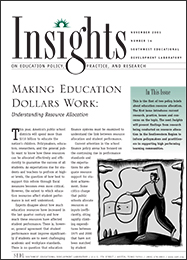Resource Allocation: A Stable Pattern Over Time
 Although experts disagree on many issues around the status of school finance, they do agree that resource allocation patterns have been remarkably stable for decades (Picus, 2001). Average per-student expenditures vary widely among the states, but fund allocations for instruction within states consistently constitute about 60 percent of total available resources. Similar patterns were found in a recently completed study of resource allocation in Texas school districts (Alexander et al., 2000). The researchers found high-performing school districts spent 57.6 percent of their operating expenditures on instruction, while low-performing districts spent slightly more (58.4 percent) and middle-performing districts a higher percentage (59.2 percent). Across the nation, within the category of instruction, the percentage of resources allocated to staff salaries also remained remarkably uniform over several decades (National Center for Education Statistics, 1998).
Although experts disagree on many issues around the status of school finance, they do agree that resource allocation patterns have been remarkably stable for decades (Picus, 2001). Average per-student expenditures vary widely among the states, but fund allocations for instruction within states consistently constitute about 60 percent of total available resources. Similar patterns were found in a recently completed study of resource allocation in Texas school districts (Alexander et al., 2000). The researchers found high-performing school districts spent 57.6 percent of their operating expenditures on instruction, while low-performing districts spent slightly more (58.4 percent) and middle-performing districts a higher percentage (59.2 percent). Across the nation, within the category of instruction, the percentage of resources allocated to staff salaries also remained remarkably uniform over several decades (National Center for Education Statistics, 1998).
Evidence gathered from all states for 1997-98 by the National Center for Education Statistics (NCES) shows instruction representing nearly 62 percent of expenditures, followed in importance by physical plant operations and maintenance at about 10 percent. General
| ||||||||||||||||||||||||
administration represents a small proportion of expenditures (about 2 percent), and school administration represents about 6 percent of expenditures. Studies by school finance experts support the results found in the NCES study (Odden, 2000; Picus, 2001). They note that across states and regions, school districts also tend to spend their resources in about the same proportions as shown in the table of NCES national results.
Occasionally, a change occurs that provides districts with a revenue wind-fall or even a permanent and large increase in resources. For example, a change in the state school finance formula that adjusts for enrollment decline or growth may benefit some school districts. Or a district may experience sharp increases in property values and local support because of regional or even national economic shifts. It has been reported that school districts experiencing revenue increases allocate their new funds in the same broad spending categories as they did before the increase. Studies conducted since the 1980s have reported that schools use new money to hire staff for their instructional programs, the largest function within the budget. However, within instruction there are important distinctions. When school systems receive additional new resources, most are not spent on staff for the core instructional program but on new technology; specialists; teacher aides; and professional development linked to programs serving at-risk students, special education students, and students with English language difficulty. In many schools, these instructional staff members serve their special-needs students in pull-out programs, reducing the overall pupil-to-teacher ratio in the school and the district but not enhancing the general education program (Odden & Archibald, 2001; Rothstein, 1997).  This pattern also is seen in districts that receive increased funds to adopt major new initiatives (Picus, 2001). These reform-oriented districts continue to retain control over most operating resources and allocate them in much the same way they were allocated before the reform initiative began.
This pattern also is seen in districts that receive increased funds to adopt major new initiatives (Picus, 2001). These reform-oriented districts continue to retain control over most operating resources and allocate them in much the same way they were allocated before the reform initiative began.
The evidence suggests that education spending in U.S. districts and schools does not change easily. Decisions regarding allocation traditionally have focused on inputs rather than outputs. For example, the stability in staffing patterns across schools serving students of similar ages by and large reflects the use of staffing formulas based on the number of students and building square-footage measures. These and other allocation formulas are not based on outputs such as student achievement or graduation rates. Many inputs are more easily measured and reported; however, with the current emphasis on accountability and results, researchers have begun to explore ways to link resources with outcomes.
Next Page: Does Money Make a Difference?: Connecting Resources to Outcomes

